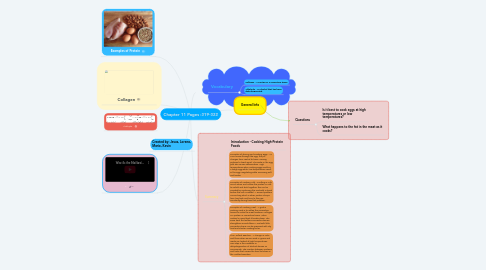Chapter 11 Pages :319-322
by Lorena Ruvalcaba

1. Collagen
2. Examples of Protein
3. -
4. Created by: Jesus, Lorena, Mario, Kevin
5. Aldehyde
6. Vocabulary
6.1. Collagen - A portein in a connective tissue
6.2. Aldehyde - An alcohol that has been dehydrogenated.
7. Summary
7.1. Introduction - Cooking High-Protein Foods
7.2. Principles of Storing and Cooking Eggs - As CO2 moves through the egg, the pH changes from neutral to basic, causing proteins to break apart. The water in the egg yolk also causes deterioration. High temperatures when cooking eggs results in a tough egg white, low temperatures result in the egg coagulating while remaining soft and tender.
7.3. Principles of Cooking Milk - Curdling in milk occurs when acid causes the protein in milk to unfold and stick together, this can be avoided by combining the acid with a starch before the milk is added. A second problem is scorching which is when protein clumps from heat sink and burn to the pan, constantly stirring fixes that problem.
7.4. Principles of Cooking Meat - A goal in cooking meat is to soften the connective tissues to make the meat tenderer. Collagen is a protein in connective tissue. When cooked in moist heat it breaks down. The same heat that softens connective tissues strengthens muscle fibers. Meat with little connective tissue can be prepared with dry heat and shorter cooking times.
7.5. The Maillard Reaction - A change in color and flavor when amino acids in grains and meats are heated at high temperatures. One step is the oxidation or dehydrogenation of alcohols known as compounds. The reaction between proteins and carbs that causes the food to brown is the Maillard Reaction.
8. General Info
9. Questions
9.1. Is it best to cook eggs at high temperatures or low temperatures?
9.2. What happens to the fat in the meat as it cooks?


